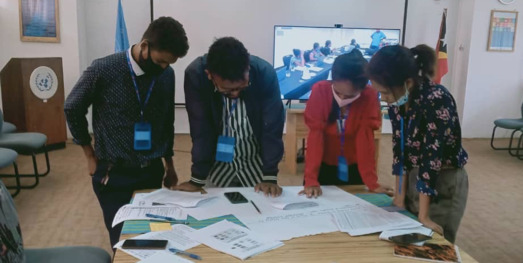Covering a total area of 1,877 km2, Municipio Viqueque is one of five sites of the GEF/UNDP/PEMSEA ATSEA-2 Programme for the Timor-Leste component. The municipality is home to around 76,033 people (according to the 2015 census), comprised predominantly of coastal communities who use double outrigger canoes and fibreglass mono-hull vessels to catch fish. Despite numerous fisheries management challenges and current capacity limitations at various levels, Timor-Leste aims to ramp up the production of red snapper fisheries to boost the incomes of coastal communities in Viqueque Municipality and beyond.

Building capacity at the appropriate planning levels in fisheries management is a critical first step towards addressing fishery management in an ecosystem context. To address the key limiting factors that have constrained sustainable red snapper fishery management in Timor-Leste, ATSEA-2 organised a training session about an Essential Ecosystem Approach to Fisheries Management (E-EAFM). Facilitated by Melbourne-based Fishwell Consulting and Bali-based Starling Resources, the training was attended by a team of 11 representatives from the Ministry of Agriculture and Fishery (MAF), Department of Fisheries, Aquaculture and Marine Resources.
“The ever-increasing challenges of illegal fishing, poor stakeholder participation, conflicts among fishermen and the low fish catch rate in artisanal fisheries are addressed in the E-EAFM implementation planning,” highlighted Jose Monteiro, a seasoned fisheries practitioner from Nino Konis Santana National Park, during his insightful presentation on EAFM for red snapper in the ATS region.
Read also: Building Resilience to Mitigate Climate Change
Concluding five days of extensive training, the team presented management actions to be implemented in a sustainable red snapper fishery in Viqueque Municipality, placing this in the practical context of developing the pilot fishery management plan. The EAFM plan targeted establishing an inter-ministerial task force for transplantation and reforestation of coral reefs and mangrove ecosystems, creating a market system, promoting an efficient transport system and empowering fishing communities with environmentally friendly fishing techniques.
Fidel de Castro Guterres is a representative from the Department of Fisheries, Aquaculture and Marine Resources at MAF. Having participated in the five days of intensive E-EAFM training, he found it to be especially useful in bridging knowledge gaps caused by a lack of experience in managing the fisheries of Timor-Leste. “The importance of applying an EAFM tool in managing fisheries sectors, especially in [the context of] Timor-Leste, is [a] very good approach,” explained Guterres at the training session. Based on his observation from many years of working in this sector, he also highlighted the various challenges faced by fisheries in this area, such as relatively smaller coastal areas, knowledge gaps and shortages of human resources. In spite of these challenges, he believes the training has provided a valuable tool in bridging these gaps and resolving the issues involved with fisheries management in the region. “Through this training I got a broader idea of how to [better] manage the fisheries sector in Timor-Leste,” said Guterres. “I gained a lot of ideas and knowledge through the E-EAFM training and I am ready [better prepared] to take the next step forward in managing fisheries in Timor-Leste, especially in the Timor Sea,” he added.

Participants at the training session were asked to prepare their final projects through a series of engaging discussions. Among the attendees were representatives from Timor-Leste who have been working in the nation’s fisheries sector for more than 20 years, which meant they had lots of useful experience and expertise to share with the group. By sharing their knowledge with the other participants, all were able to identify weaknesses in current management approaches, and devise solutions based on the various principles covered in E-EAFM training materials.
Surveys of the Timor Sea1 have identified snapper as being the most commonly fished species, comprising 49.32% of the total catch. Within the snapper group, there are three distinct individual species of high economic importance: Pristipo moidestypus, P.mutidens and Lutjanus vitta. These are especially important, both for subsistence and for the generation of income, not only at the coastal villages but also at the national level.
Read also: Analysing the Potential Economic Impacts of IUU Fishing in Indonesia
The ATSEA-2 Programme’s training followed FAO-certified training modules on EAFM. These cover both theory and practical aspects of EAFM, which have been adapted to meet the specific needs of the Arafura-Timor Sea red snapper fishery. Following the completion of the training, 15 high-performing participants will be selected to undertake a three-day Training of Trainer (ToT) course in relation to EAFM.
(Almerindo Oliveira Da Silva)


